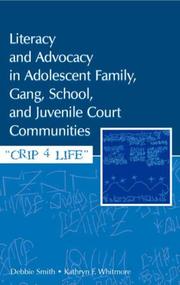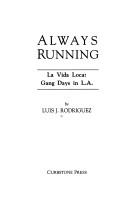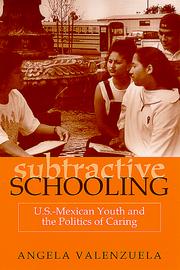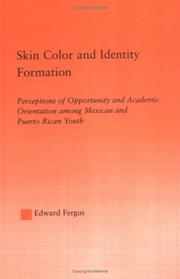| Listing 1 - 7 of 7 |
Sort by
|
Book
ISBN: 9004439102 9004439110 9789004439115 9789004439108 9789004439108 Year: 2021 Publisher: Leiden Boston
Abstract | Keywords | Export | Availability | Bookmark
 Loading...
Loading...Choose an application
- Reference Manager
- EndNote
- RefWorks (Direct export to RefWorks)
Based on a multi-year ethnography in one Spanish-speaking community in New Jersey, this book is a meticulous account of six Mexican families that explores the relationship between siblings' language use patterns, practices, and ideologies. Combining insights gained from language socialization and heritage language studies within the larger field of sociolinguistics, the book's findings examine siblings' sociolinguistic environments and the ways in which these Latino children use and view their multilingual resources in the home, school, and broader community. This study emphasizes the links between siblings' language ideologies, agentive decision making, and linguistic patterns, and the ways in which birth order influences the different dimensions of heritage language maintenance in the U.S.
Bilingualism in children --- Mexican American youth --- Youth, Mexican American --- Youth --- Children --- Language. --- Language

ISBN: 1135600554 1283707772 1282375830 9786612375835 1410617432 9781410617439 9780805855982 080585598X 9780805855999 0805855998 080585598X 0805855998 9781135600556 9781135600501 1135600503 9781135600549 1135600546 9781283707770 9781282375833 6612375833 Year: 2006 Publisher: Mahwah, N.J. : Lawrence Erlbaum Associates,
Abstract | Keywords | Export | Availability | Bookmark
 Loading...
Loading...Choose an application
- Reference Manager
- EndNote
- RefWorks (Direct export to RefWorks)
Encourages educators and researchers to understand the complexities of adolescent gang members' lives in order to rethink their assumptions about these students in school. This book is useful for education researchers, professionals, and students in the areas of middle/high school education, and alternative community programs.
Gang members --- Juvenile delinquents --- Mexican American youth --- Teacher-student relationships --- Gangs --- Literacy --- Marginality, Social --- Youth, Mexican American --- Youth --- Delinquents --- Delinquents, Juvenile --- Juvenile offenders --- Offenders, Juvenile --- Offenders, Youthful --- Young offenders --- Youthful offenders --- Criminals --- Members of gangs --- Persons --- Education

ISBN: 0313011001 9780313011009 0313318271 9780313318276 128046867X 9786610468676 9798400682582 Year: 2002 Publisher: Westport, Conn. Greenwood Press
Abstract | Keywords | Export | Availability | Bookmark
 Loading...
Loading...Choose an application
- Reference Manager
- EndNote
- RefWorks (Direct export to RefWorks)
Mexican American criminals --- Mexican American youth --- Gangs --- Television broadcasting of news --- Crews (Gangs) --- Crime syndicates --- Street gangs --- Teen gangs --- Teenage gangs --- Criminals --- Juvenile delinquents --- Hoodlums --- Youth, Mexican American --- Youth --- Criminals, Mexican American --- Press coverage

ISBN: 1880684063 Year: 1993 Publisher: Willimantic, Conn. Curbstone Press
Abstract | Keywords | Export | Availability | Bookmark
 Loading...
Loading...Choose an application
- Reference Manager
- EndNote
- RefWorks (Direct export to RefWorks)
343.946 <73> --- Gangs --- -Mexican American youth --- -Youth, Mexican American --- Youth --- Crews (Gangs) --- Crime syndicates --- Street gangs --- Teen gangs --- Teenage gangs --- Criminals --- Juvenile delinquents --- Hoodlums --- Jeugddelinkwentie--Verenigde Staten van Amerika. VSA. USA --- Biography --- Rodriguez, Luis J. --- -Jeugddelinkwentie--Verenigde Staten van Amerika. VSA. USA --- 343.946 <73> Jeugddelinkwentie--Verenigde Staten van Amerika. VSA. USA --- Mexican American youth --- Youth, Mexican American --- Rodriguez, Luis J., --- California --- Los Angeles (Calif.) --- Itzlacuiloh, Mixcoatl

ISBN: 0585281009 9780585281001 0791443213 0791443221 9780791443217 9780791443224 0791443213 9780791443217 9781438443224 1438422628 9781438422626 Year: 1999 Publisher: Albany, N.Y. State University of New York Press
Abstract | Keywords | Export | Availability | Bookmark
 Loading...
Loading...Choose an application
- Reference Manager
- EndNote
- RefWorks (Direct export to RefWorks)
"Subtractive Schooling provides a framework for understanding the patterns of immigrant achievement and U.S.-born underachievement frequently noted in the literature and observed by the author in her ethnographic account of regular-track youth attending a comprehensive, virtually all-Mexican, inner-city high school in Houston. Valenzuela argues that schools subtract resources from youth in two major ways: firstly by dismissing their definition of education and secondly through assimilationist policies and practices that minimize their culture and language. A key consequence is the erosion of students' social capital evident in the absence of academically oriented networks among acculturated, U.S.-born youth."--Jacket.
Mexican Americans --- Children of immigrants --- Mexican American youth --- Hijos de inmigrantes --- Juventud mexicano americana --- Provision of education. --- Educational policy. --- Youth. --- Mexicans. --- Youth, Mexican American --- Youth --- First generation children --- Immigrants' children --- Second generation children --- Immigrants --- Chicanos --- Hispanos --- Ethnology --- Education (Secondary) --- Social conditions --- Educación secundaria --- Condiciones sociales
Book
ISBN: 1609173759 9781609173753 9781611860863 1611860865 Year: 2013 Publisher: East Lansing
Abstract | Keywords | Export | Availability | Bookmark
 Loading...
Loading...Choose an application
- Reference Manager
- EndNote
- RefWorks (Direct export to RefWorks)
The population of Mexican-origin peoples in the United States is a diverse one, as reflected by age, class, gender, sexuality, and religion. Far from antiquated concepts of mestizaje, recent scholarship has shown that Mexican@/Chican@ culture is a mixture of indigenous, African, and Spanish and other European peoples and cultures. No one reflects this rich blend of cultures better than Chican@ rappers, whose lyrics and iconography can help to deepen our understanding of what it means to be Chican@ or Mexican@ today. While some identify as Mexican mestizos, others identify as ind
Mexican American youth --- Rap (Music) --- Hip-hop --- Mexican Americans --- Hip-hop culture --- Hiphop --- African American arts --- Popular culture --- Hip-hop music --- Rap songs --- Rappin' (Music) --- Rapping (Music) --- African Americans --- Monologues with music --- Popular music --- Trip hop (Music) --- Youth, Mexican American --- Youth --- Social life and customs. --- Social aspects --- Social conditions. --- Influence. --- Ethnic identity.

ISBN: 1135931305 1280168323 0203338243 041594970X 0415651719 1135931291 Year: 2004 Publisher: New York : Routledge,
Abstract | Keywords | Export | Availability | Bookmark
 Loading...
Loading...Choose an application
- Reference Manager
- EndNote
- RefWorks (Direct export to RefWorks)
The focus of this study is on the ways in which skin color moderates the perceptions of opportunity and academic orientation of 17 Mexican and Puerto Rican high school students. More specifically, the study's analysis centered on cataloguing the racial/ethnic identification shifts (or not) in relation to how they perceive others situate them based on skin color.
Mexican Americans --- Puerto Ricans --- Mexican American youth --- Puerto Rican youth --- Urban high schools --- Human skin color --- Education (Secondary) --- Race identity --- Attitudes. --- Social aspects --- Color of human beings --- Color of man --- Human beings --- Pigmentation of human skin --- Skin --- Skin color, Human --- Skin pigmentation, Human --- Youth, Puerto Rican --- Youth, Mexican American --- Chicanos --- Hispanos --- Color --- High schools --- Urban schools --- Youth --- Ethnology --- Boricuas --- puerto --- rican --- students --- academic --- orientation --- ethnic --- identification --- cultural --- ecological --- model
| Listing 1 - 7 of 7 |
Sort by
|

 Search
Search Feedback
Feedback About UniCat
About UniCat  Help
Help News
News